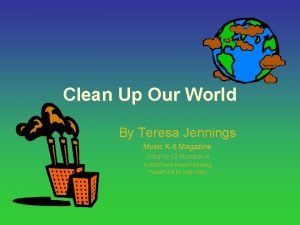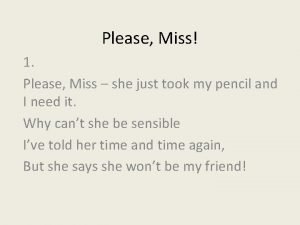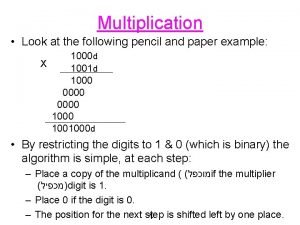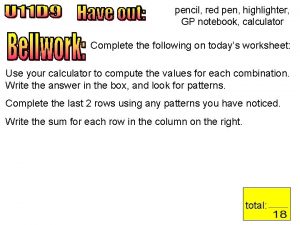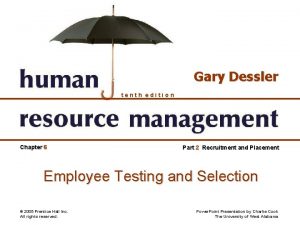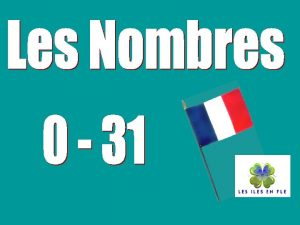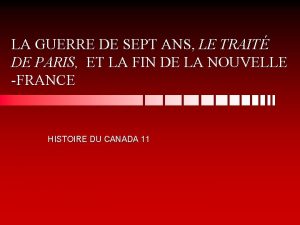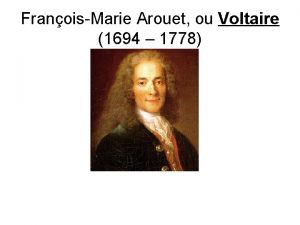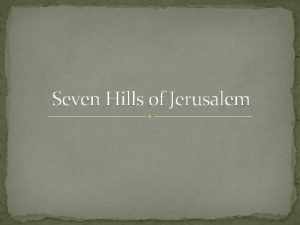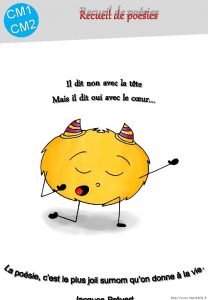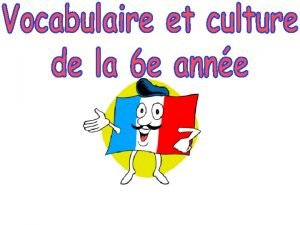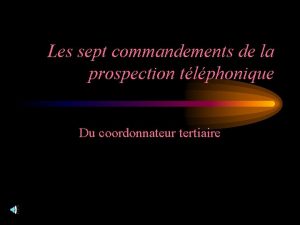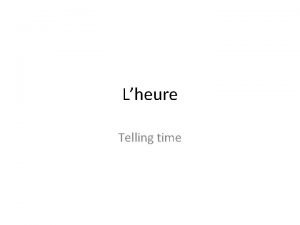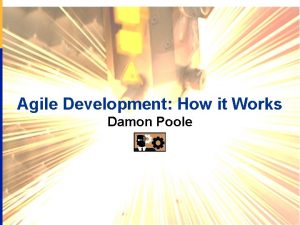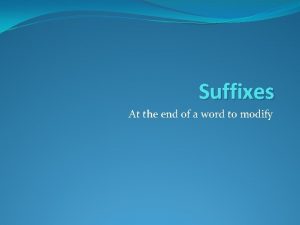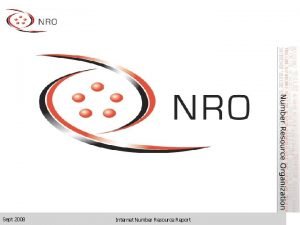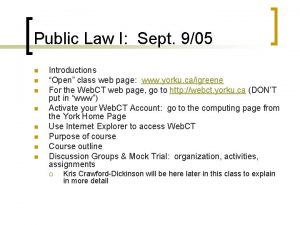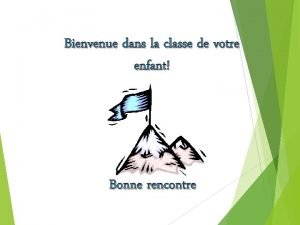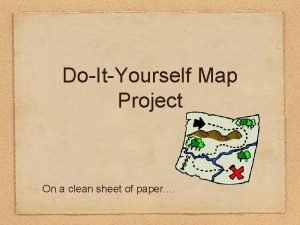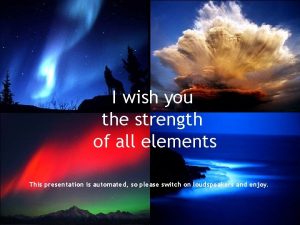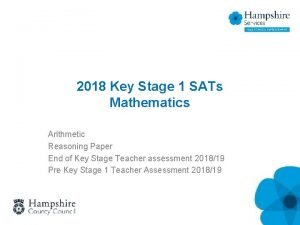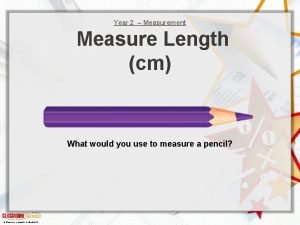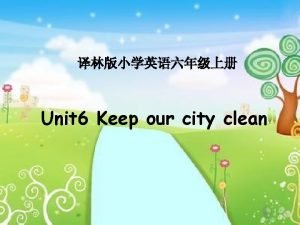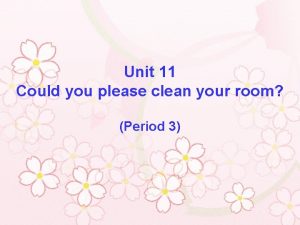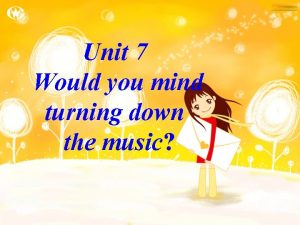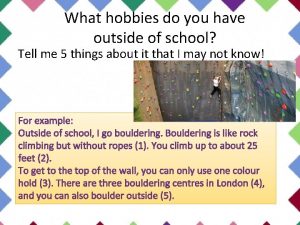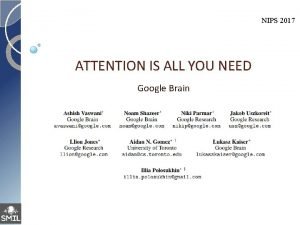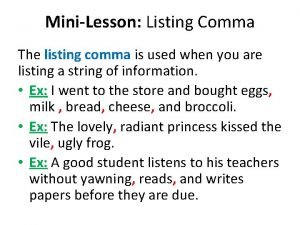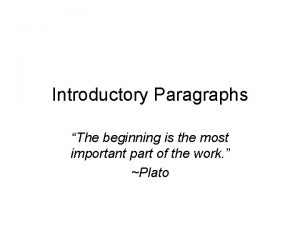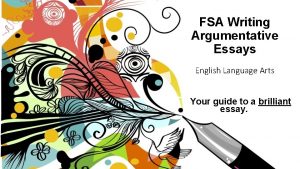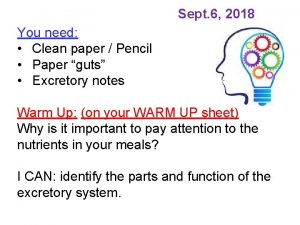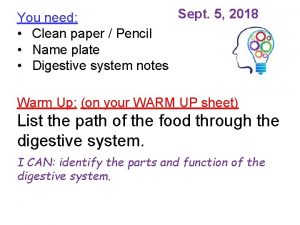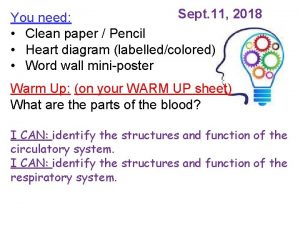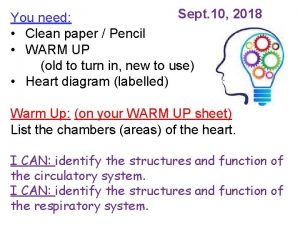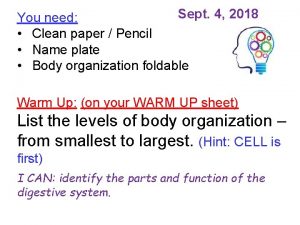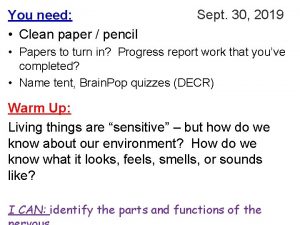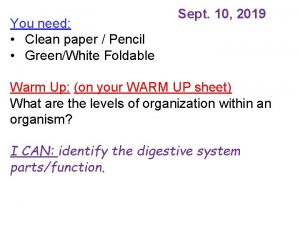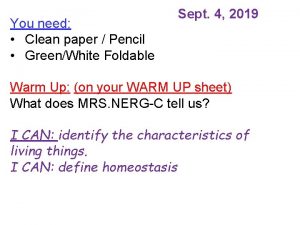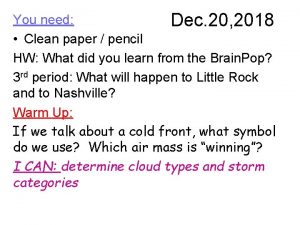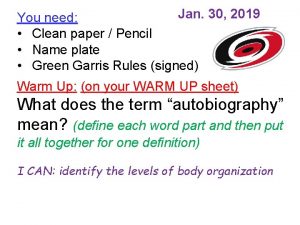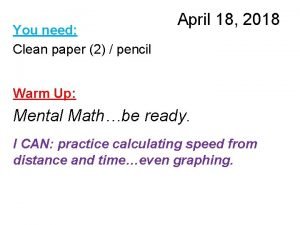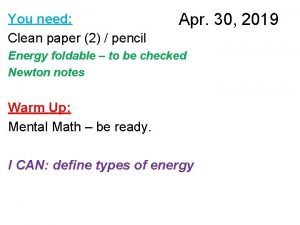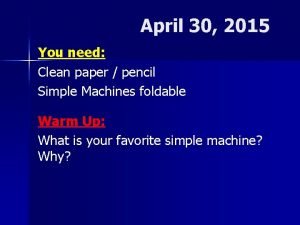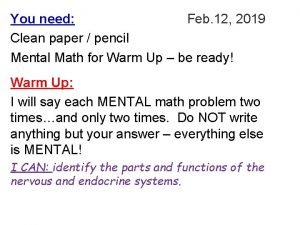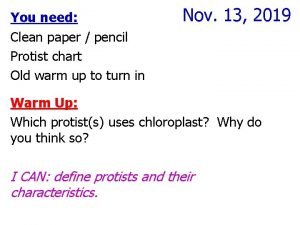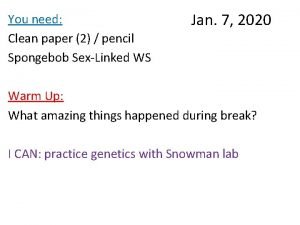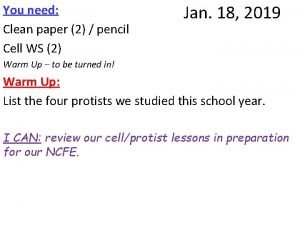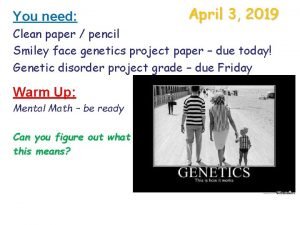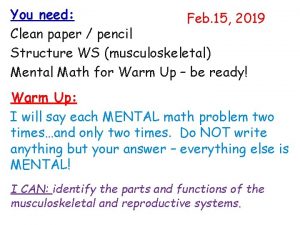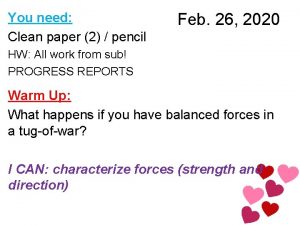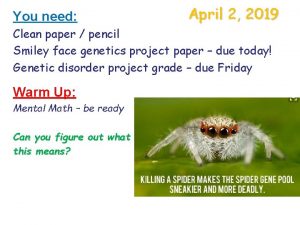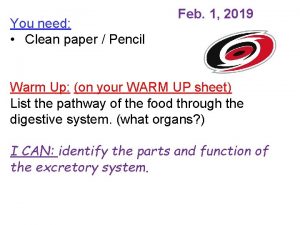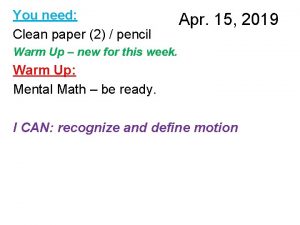You need Sept 27 2018 Clean paper pencil












































- Slides: 44

You need: Sept. 27, 2018 Clean paper / pencil HW: Intro to Microscopes (Task sheet) Cell coloring page Warm Up: What does an animal cell look like? I CAN: identify a basic animal cell and some organelles.

Housekeeping! v. Review v. Best behavior! – Cougar Mountain/subs/drills/silent lunch v. Progress reports – YESTERDAY!! v. Data sheets, etc

Today • • Review lab, timeline, microscope CELLS – animal Organelles Housekeeping

The lead up to cells… • Robert Hooke – first to say “CELLS” b/c cork looked like empty rooms. Was looking at dead wood cells. • Anton Van Leeuvenhoek – first to say “Animalcules” as he looked at MOVING stuff…seeing LIVING organisms.

The lead up to cells… • Schleiden…looked at lots of plants and could say with confidence that all plants were made of CELLS. • Schwann…looked at lots of animals and felt confident saying that all animals were made of CELLS. • Virchow – helped the other two finally agree that CELLS come from other CELLS.

The lead up to cells… Schleiden, Schwann, Virchow are credited with the Cell Theory: • All organisms are made of one or more CELLS. • CELLS are the basic unit of structure and function in all living things. • All CELLS come from pre-existing CELLS.

Compound Microscope 2. Body Tube – gives distance between eyepiece and objective. 3. Nose Piece – holds the objectives. 5. Objectives lens closest to the slide. 7. Stage clips – Holds the slide in place. 9. Diaphragm – Controls the amount of light. 11. Light – Shines light through the slide, lens, tube. 1. Eye Piece – lens closest to the eye. 4. Arm – holds the tube and lenses. 6. Stage – platform for the slides. 8. Coarse Adjustment knob – Moves stage up/down (to focus). 10. Fine Adjustment knob – Moves stage up/down slightly 12. Base – Holds up the entire microscope.


e e


A Cell membrane Nucleus Nucleolus Cytoplasm G Mitochondrion A Golgi complex

A Vacuole Lysosome Ribosome G A Endoplasmic Reticulum (smooth) Endoplasmic Reticulum (rough)


Cells!!!

On the laptop… You may use Brain. Pop to help with microscope use AND with “building” an animal cell (and learning the parts). • Brain. Pop • Username: carrington 1 • Password: cougars • Search for “Using the Microscope” – work through • Search “Build-a-cell” (for animal cells) – work through


Cell Songs: nhttps: //youtu. be/r. ABKB 5 a. S 2 Zg (country) nhttps: //youtu. be/Nk. C 9 Ai. Jf 7 g. I (slow jam? ) nhttps: //youtu. be/-zaf. JKb. MPA 8 (teacher rap)

Amoeba Sisters – intro cells https: //youtu. be/8 Ilz. Kri 08 kk Write the names of the organelles that you hear in the video.





Cells and their Organelles • Organelles are like organs…but MUCH smaller. 1. At what level of organization does life begin? 2. What surrounds all cells? 3. What is meant by semi-permeable?

Cells and their Organelles • Organelles are like organs…but MUCH smaller. 4. The cell membrane is also called the ________ membrane. 5. Centrioles are found inside what type of cell? 6. What additional layer is found around the outside of a plant cell?

Cells and their Organelles DNA = deoxyribonucleic acid 7. Where is DNA found inside the cell? 8. What cell process is controlled by the nucleus? 9. DNA coils tightly during division and assembles into visible _________.

Cells and their Organelles DNA = deoxyribonucleic acid • Where are organelles located? • Where are proteins made in the cell? • Do all cells need ribosomes? • The process of making proteins is called _________________.

Cells and their Organelles Endoplasmic reticulum • • • How does rough ER differ from smooth ER? Rough ER is connected to the ____________ and to the __________ ER. Proteins made by rough ER travel to the Golgi in

CELLS

Cell Membrane • BOTH Plant and Animal Cells • Function: controls what substances enter and exit the cell • Analogy to City: City “Gate Keeper”

Cell Wall • PLANT CELLS ONLY • Function: surrounds plants to protect and support the cell • Analogy to City: City Border

Nucleus • BOTH Plant and Animal Cells • Function: directs all the cells activities (brain of cell) • Analogy to City: City Hall

Nucleolus • BOTH Plant and Animal Cells • Function: makes ribosomes inside the nucleus • Analogy to City: Copy Machine Inside City Hall

Nuclear Membrane • BOTH Plant and Animal Cells • Function: controls what enters and leaves the nucleus, protects • Analogy to City: gate around City Hall

Chromosomes • BOTH Plant and Animal Cells • Function: contains the important blueprints of the cell or DNA • Analogy to City: City Mayor

Vacuole • BOTH Plant and Animal Cells • Function: stores food, water, waste, and other materials • Analogy to City: Warehouses, Water Towers, etc.

Chloraplast • PLANT CELLS ONLY • Function: captures energy from sunlight and produces food • Analogy to City: Solar Energy Plant

Endoplasmic Reticulum • BOTH Plant and Animal Cells • Function: built proteins and move them throughout cell or out of cell (Smooth – no ribosomes, Rough – ribosomes) • Analogy to City: City Transportation Department

Cytoplasm • BOTH Plant and Animal Cells • Function: gel-like fluid between cell membrane and nucleus, allows other organelles to float freely through cell • Analogy to City: City Yards

Ribosomes • BOTH Plant and Animal Cells • Function: produce proteins • Analogy to City: Construction Company

Lysosomes • ANIMAL CELLS ONLY • Function: contain chemicals that break down food particles and worn out cell parts • Analogy to City: Recycle or Waste Management Company

Mitochondria • BOTH Plant and Animal Cells • Function: rod-shaped organelle that produce energy (powerhouse) • Analogy to City: Energy Plant

Golgi Body • BOTH Plant and Animal Cells Post • Function: Office receives materials from the endoplasmic reticulum and sends them to other parts of the cell • Analogy to City: Post Office

The Whole City… Post Office

1. Choose the wrong statement from the following. a) Mitochondria produces most of the energy for the cell. b) Chloroplasts are “food producers. ” c) Cell wall controls the movements of materials into and out of the cell. d) Nucleus regulates and controls all cell activities, acting as the “brain” of the cell.
 Clean up everybody let's clean up
Clean up everybody let's clean up Please miss just once
Please miss just once Multiplication of binary numbers
Multiplication of binary numbers Duotangs,paper,pencil,eraser,calculator,pens,highlighter
Duotangs,paper,pencil,eraser,calculator,pens,highlighter Paper and pencil honesty test
Paper and pencil honesty test Une deux trois quatre cinq
Une deux trois quatre cinq Deportes
Deportes La guerre de sept ans
La guerre de sept ans 7 hills of jerusalem
7 hills of jerusalem Poésie l'embouteillage
Poésie l'embouteillage Ecrivez les sept jours de la semaine
Ecrivez les sept jours de la semaine Sept commandements
Sept commandements Cnn 10 september 3
Cnn 10 september 3 Sept heure moins le quart
Sept heure moins le quart Damon poole
Damon poole What does the prefix sept mean
What does the prefix sept mean Sept
Sept I sept
I sept Sept comme setteur questionnaire
Sept comme setteur questionnaire Que letra continua m v t m j
Que letra continua m v t m j Clean sheet of paper
Clean sheet of paper Copy the diversity card on a clean sheet of paper
Copy the diversity card on a clean sheet of paper On a clean sheet of paper draw yourself
On a clean sheet of paper draw yourself I wish you all the strength
I wish you all the strength New speaker new line worksheet
New speaker new line worksheet Arithmetic sats 2018
Arithmetic sats 2018 Year 2 measuring in cm
Year 2 measuring in cm Keeping our city clean
Keeping our city clean I've told you a million times to clean your room
I've told you a million times to clean your room Do you mind clean
Do you mind clean Please clean the room before you live
Please clean the room before you live Please clean your own room
Please clean your own room Please clean your room
Please clean your room Paper 2 aice general paper
Paper 2 aice general paper Hand approach general paper
Hand approach general paper It can be quite busy here during the tourist
It can be quite busy here during the tourist 5 hobbies you need
5 hobbies you need You only need to be lucky once
You only need to be lucky once Attention is all you need
Attention is all you need Do you need a comma before since
Do you need a comma before since Love is not all rhyme scheme
Love is not all rhyme scheme What to have in an introduction paragraph
What to have in an introduction paragraph Argumentative essay format
Argumentative essay format Signature on passport
Signature on passport Argumentative genre examples
Argumentative genre examples
